| v1.2 | 20/08/2020 |
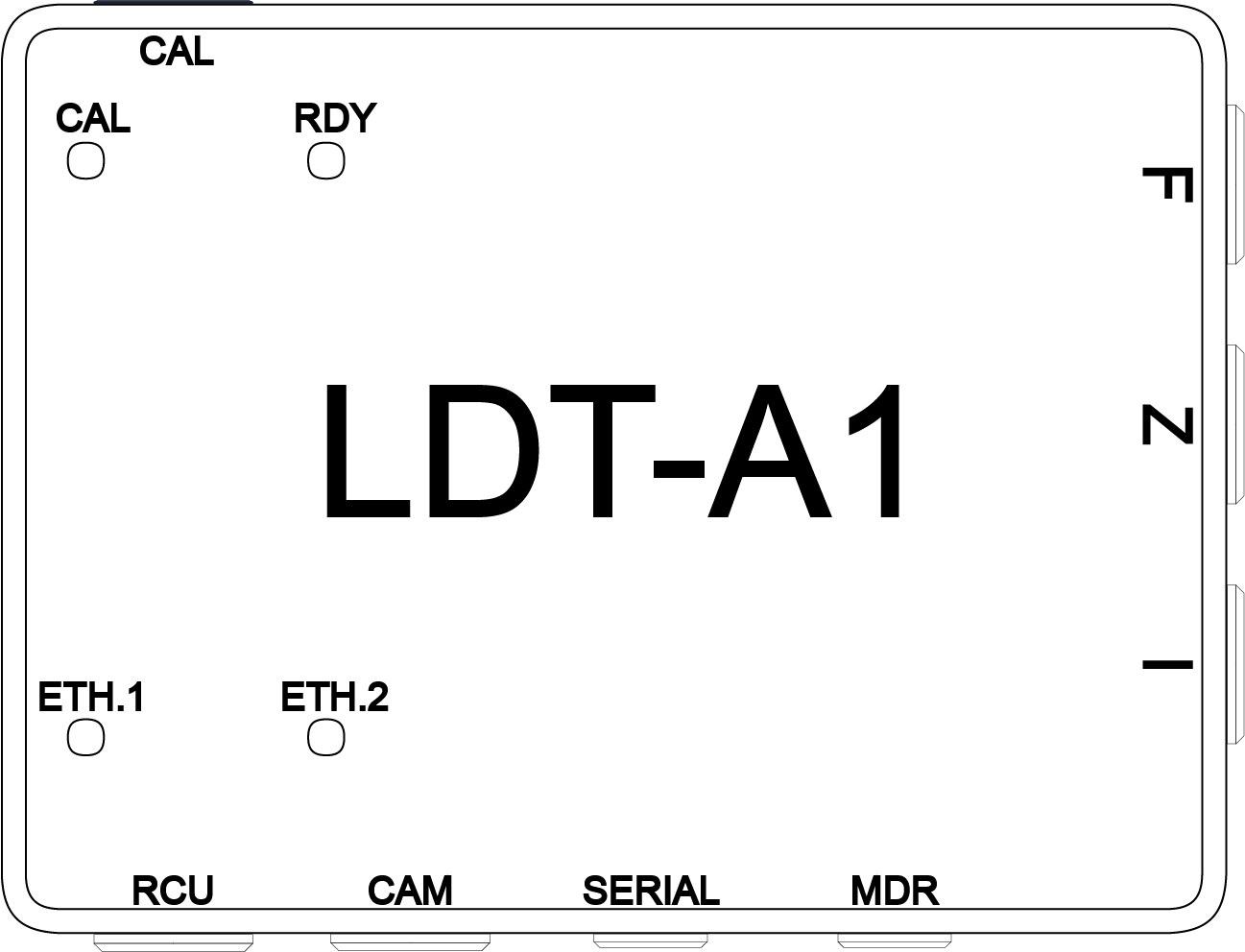
¶ Introduction
DCS’ LDT-A1 is a lens encoding system for the Arri ALEXA family (XT, SXT, LF, 65). It reads the Focus, Iris and Zoom motor movements and translates this information into compatible data for the host camera. This metadata is then written directly into the ArriRaw camera files in real time.
Note on Zoom Lenses: If zoom lenses are being used during the production, the LDT-A1 works in conjunction with the Preston Digital MicroForce. If using an Arri LDE-1 or DCS’ LDT-E1 lens encoder, please use the LDT-A2 instead. Contact DCS for more information.
¶ LDT-A1 Components
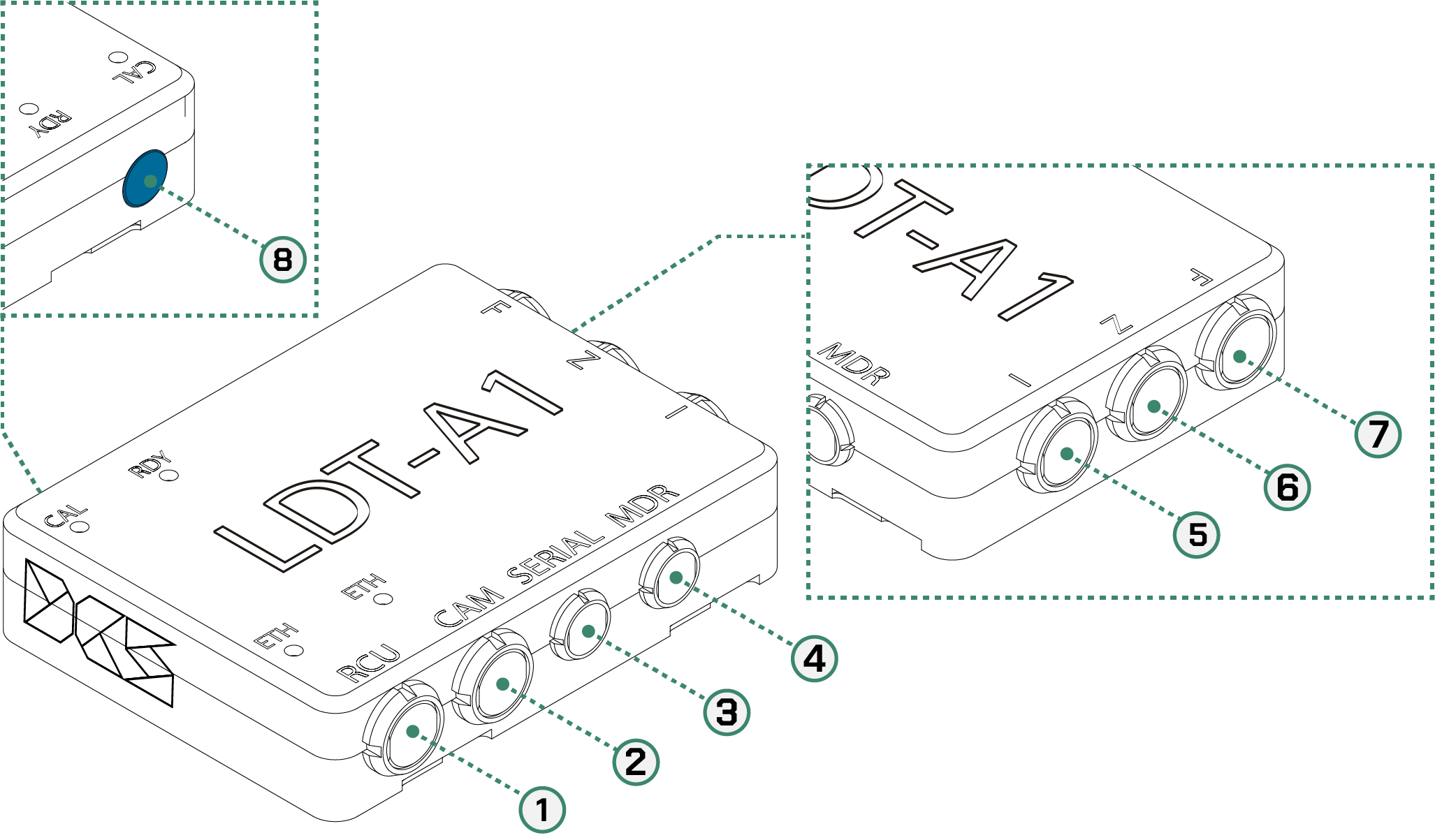
| 1 | RCU | 10-pin 1B Lemo | 5 | I | 5-pin 1B Lemo | ||
| 2 | CAM | 10-pin 1B Lemo | 6 | Z | 5-pin 1B Lemo | ||
| 3 | SERIAL | 4-pin 0B Lemo | 7 | F | 5-pin 1B Lemo | ||
| 4 | MDR | 4-pin 0B Lemo | 8 | CAL | Calibration Button |
¶ Physical Connections
| Name | Type | Description | Cable Codes |
|---|---|---|---|
| RCU | 10-pin 1B Lemo | Camera Ethernet Loop out | ETHA |
| CAM | 10-pin 1B Lemo | Ethernet connection to Camera | ETH |
| SERIAL | 4-pin 0B Lemo | Serial passthrough connection port | CT |
| MDR | 4-pin 0B Lemo | Preston MDR Serial connection port | MDR, MDRP |
| F | 5-pin 1B Lemo | Alexa CLM Focus connection port | FIZ |
| I | 5-pin 1B Lemo | Alexa CLM Focus connection port | FIZ |
| Z | 5-pin 1B Lemo | Alexa CLM Focus connection port | FIZ |
¶ Cable Types and Codes
All DCS cables are categorized using a code and a bend relief color for each of the cable types. Cables have two default lengths, 12, 18 or 24 inches and the connector type can be straight (S), right angle (R), or anglissimo (O). Custom cables can be made upon request.
| Code | Bend Relief Color | Type Port Name |
Description |
|---|---|---|---|
| ETHA | Black | 10-Pin 1B Lemo to RJ-45 RCU |
ETHA cable connects the LDT-A1 to a computer for lens table creation and firmware updating. |
| ETH | White | 10-Pin 1B Lemo to 10-pin 1B Lemo CAM |
ETH cable connects LDT-A1 to the ethernet port of the Alexa camera. |
| CT | Orange | 4-pin 0B Lemo to 6-pin 1B Lemo SERIAL |
CT cable connects the Preston MDR 2 or 3 serial port with a CineTape. This cable connects to the LDT-A1 Serial connector if the Preston MDR serial ports are in use. |
| MDR | Blue | 4-pin 0B Lemo to 4-pin 0B Lemo MDR |
MDR cable connects the LDT-A1 to a Preston MDR 2 or 3 serial port. |
| MDRP | Blue | 4-pin 0B Lemo to 4-pin 0B Lemo MDR |
MDRP cable connects the LDT-A1 to a Preston MDR 2 or 3 serial port. Also provides power. |
| FIZ | Green | 5-pin 0B Lemo to 12-pin S103 Fischer F, I & Z |
FIZ cable connects the LDT-A1 to the focus, zoom and iris CLM ports of the Alexa camera. It injects the encoded data into the RAW file. |
¶ Setting up the Preston
Setup the Focus / Iris / Zoom direction for natural use on the Preston. If you are using a separate iris or zoom handset then connect this now and ensure the direction of the preston motors are correct.
The Preston MDR3 must be running the latest firmware. Please update your MDR 3 first. In case of using MDR2 or MDR4 please contact DCS support for more information and supported firmware versions.
In order to correctly create lens maps, Preston F-Mapping must be disabled. This can be enabled for normal operation once the lens tables have been made but it is essential it’s disabled during setup.
¶ Setting up the Arri Alexa
Press the WRS button to go to the WRS screen. From here, all camera settings related to the Wireless Remote System can be accessed.
- Choose
WRS > Lens data > Options > LDS mount > Off - Set
Lens distance unitto the distance unite mesure in use
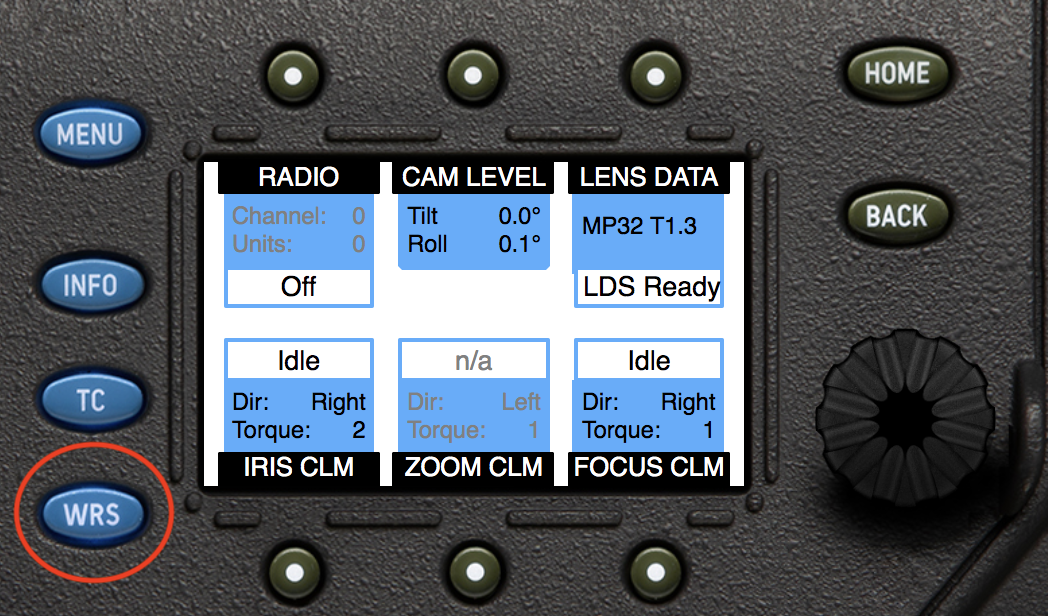
¶ Overlay Lens Data on monitor
In order to display lens data as an overlay on an SDI monitor, do the following.
- Choose
MENU > Monitoring > SDI > SDI processing > Overlays > Status components - Select
Lens data
¶ Rigging the camera
- Connect the LDT-A1 using the MDRP Blue Cable from the MDR port on the LDT-A1 to the Serial port on the Preston MDR-3.
- Plug the ETH white cable from the CAM port on the LDT-A1 to the Ethernet connector on the bottom left of the Alexa.
- Connect the green FIZ cables from the LDT-A1 to CLM Iris, Zoom and Focus ports on the side of the Alexa.
Only connect the corresponding cables for your lens eg. do not connect the Zoom cable if you are not using a zoom lens.
- Connect the Preston Hand unit to the MDR.
- Hold the calibration button on the LDT-A1 for 2 seconds to calibrate the lens. Visually check all active axes are calibrating.
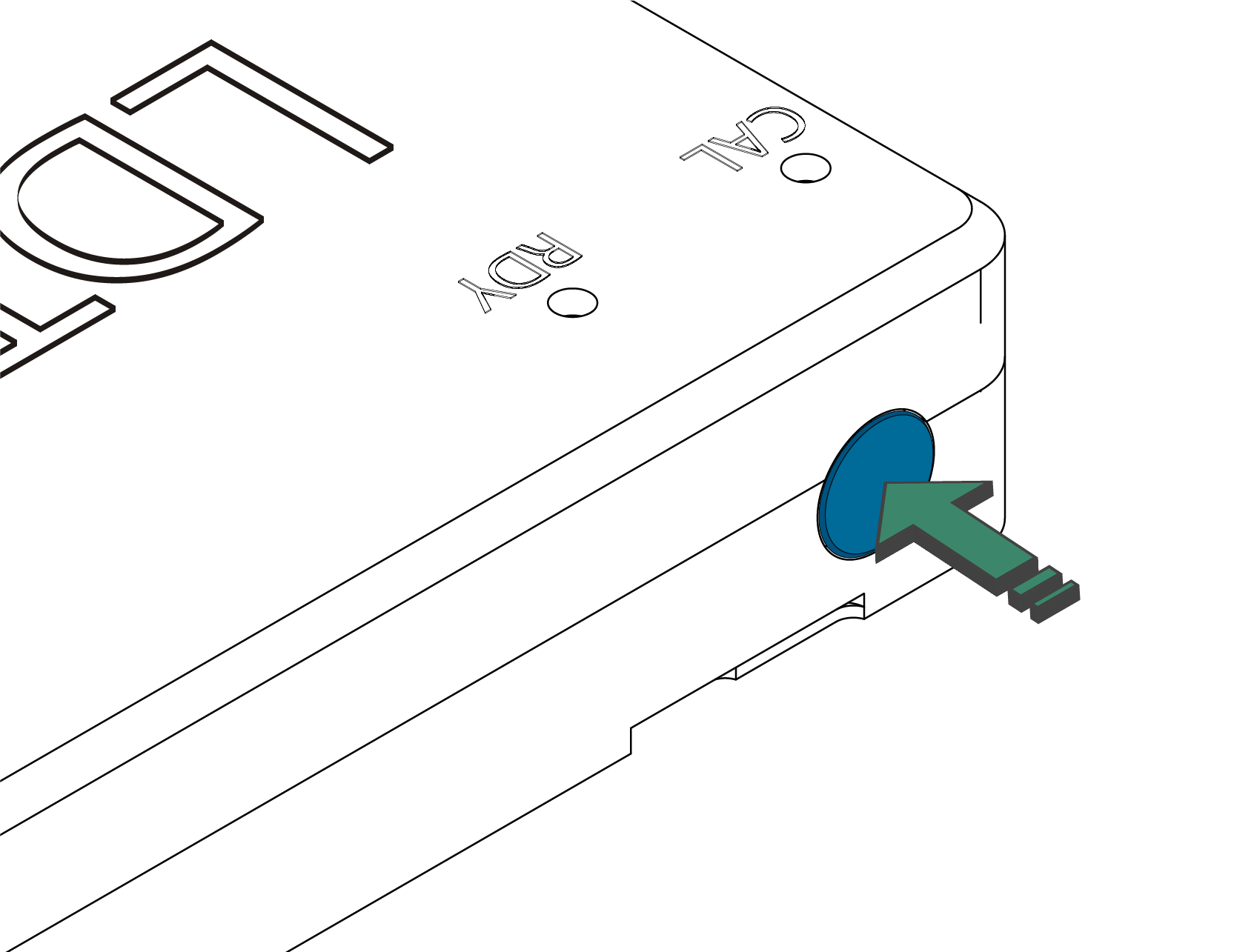
Please note: this system requires that the MDR is always calibrated from the LDT, not from the button on the MDR itself.
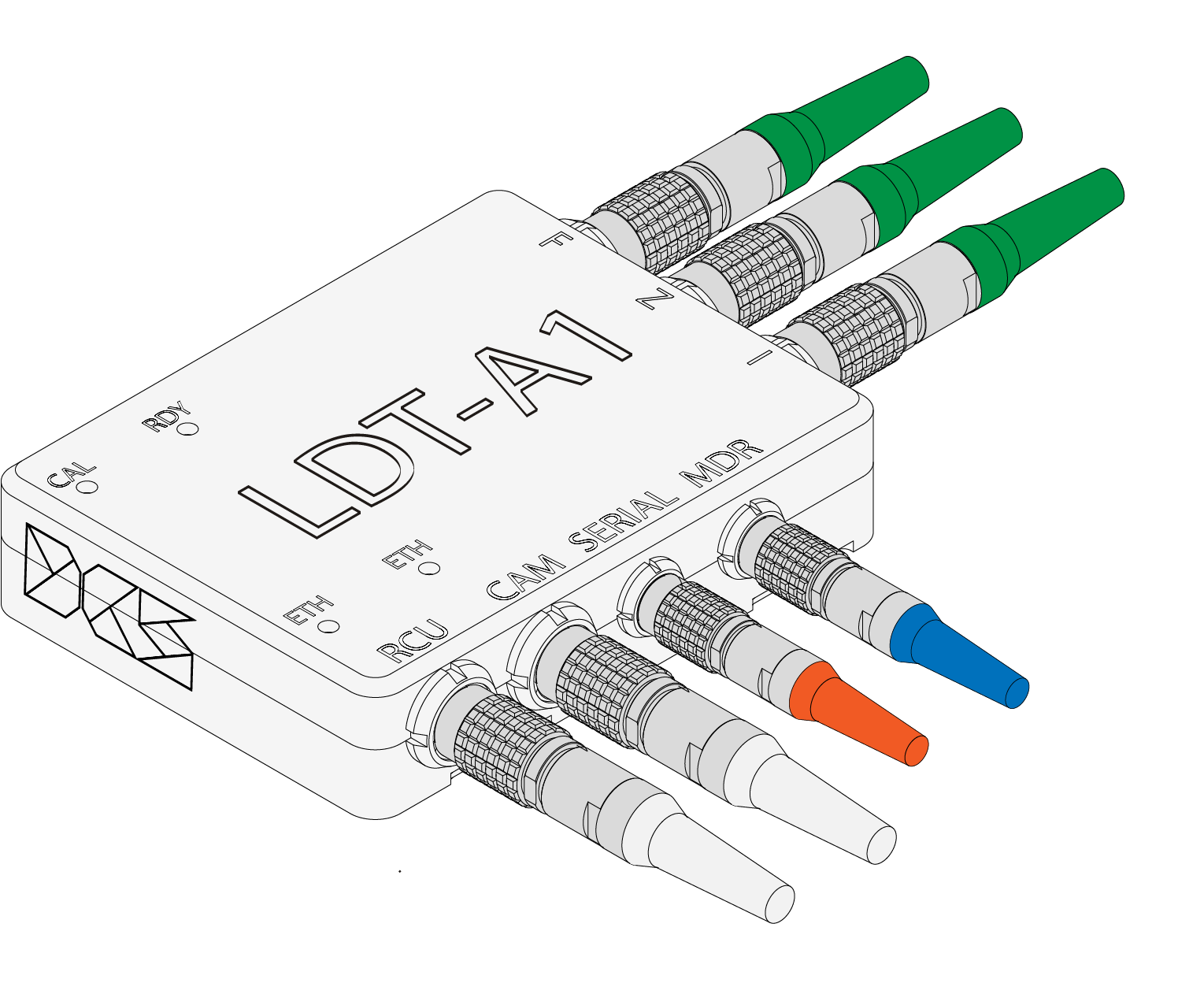
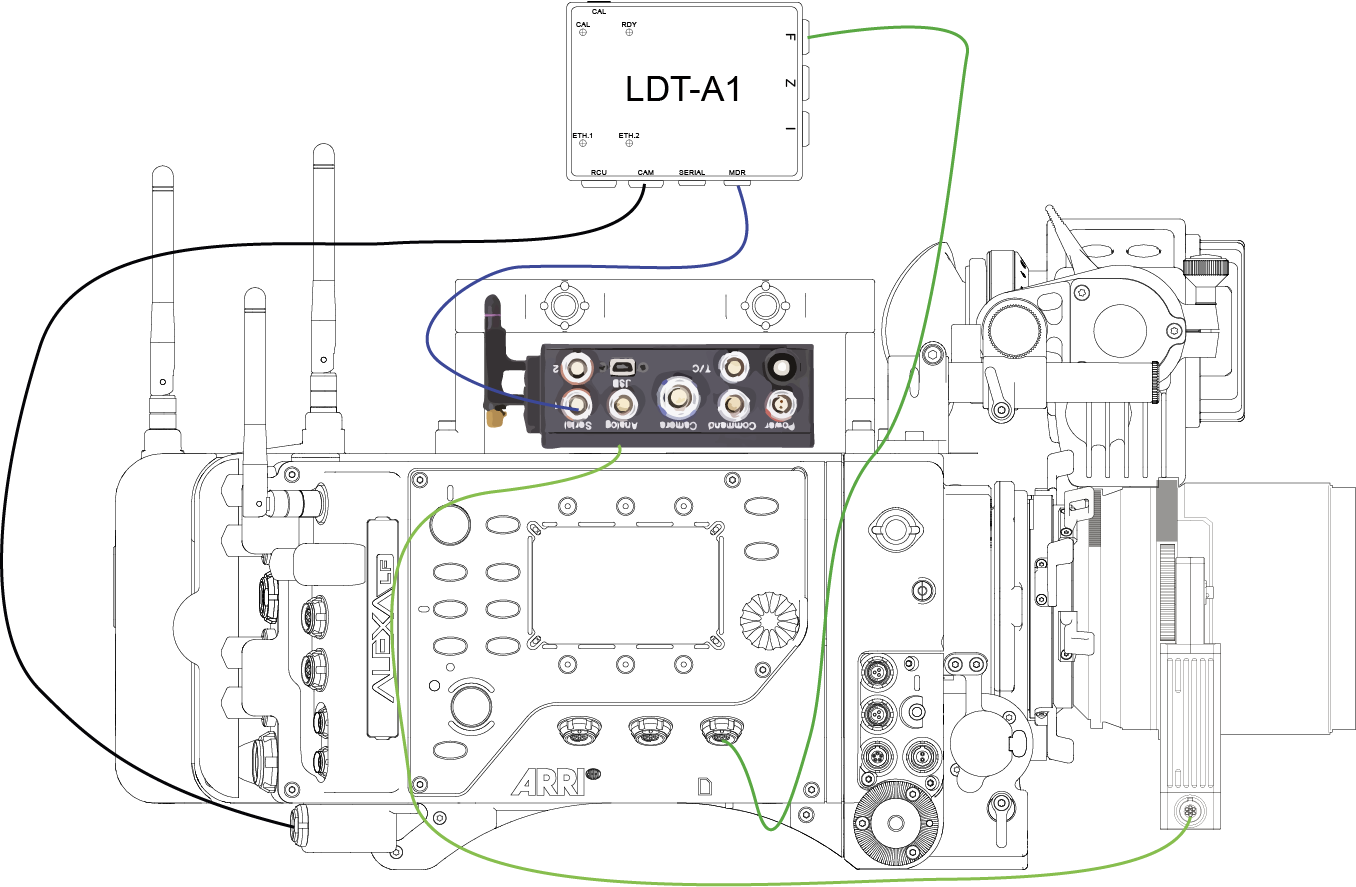
¶ Programming a New Lens Table
Creating a lens table is essential to the encoding process. It requires inputting the relevant lens information (lens name, brand, serial number etc.) and then inputting all of the marks from each axis (focus/iris/zoom) for each lens. The following guide explains this process.
¶ Creating a New Lens Table
Mapping a new lens table is crucial to ensuring that the data encoded throughout the production is precise.
When mapping a lens, a methodical process needs to be adopted. As standard practice, DCS suggests to enter a mark point on the LDA (Lens Data Archive for non-LDS Lenses) for each engraved mark on the lens and let the system interpolate the rest of the data.
Ensure that the lens calibration happens without any motor slip. When moving the lens axis with a remote handset, mark alignment should always be achieved from the same direction to avoid slack on the lens.
¶ Initial check
Establish which direction will be used on the Preston HU3 for the run of the show (close focus, infinity, wide open iris, close iris, wide zoom, tight zoom). DCS suggests keeping it consistent throughout the whole set of lenses.
Do not move Preston Motors or change direction while encoding the lenses unless required by rigging purpose.
Remember to insert an SD card into the slot of the camera before starting.
Always calibrate the lens from the LDT-A1 calibration button.
The directions of the Focus, Iris, and Zoom axis on the camera may have to be changed to match the direction of the Preston motors. In order to change the motor direction on the camera:
- Choose
WRS > choose Iris CLM, Zoom CLM, Focus CLM > choose LEFT or RIGHT
¶ Connecting to the Camera
In order to add a new lens into the LDA, connect the ETHA cable to the LDT-A1 RCU port and the RJ-45 end to your laptop (this Arri cable can be used instead: ALEXA Ethernet Remote Cable KC 157-S).
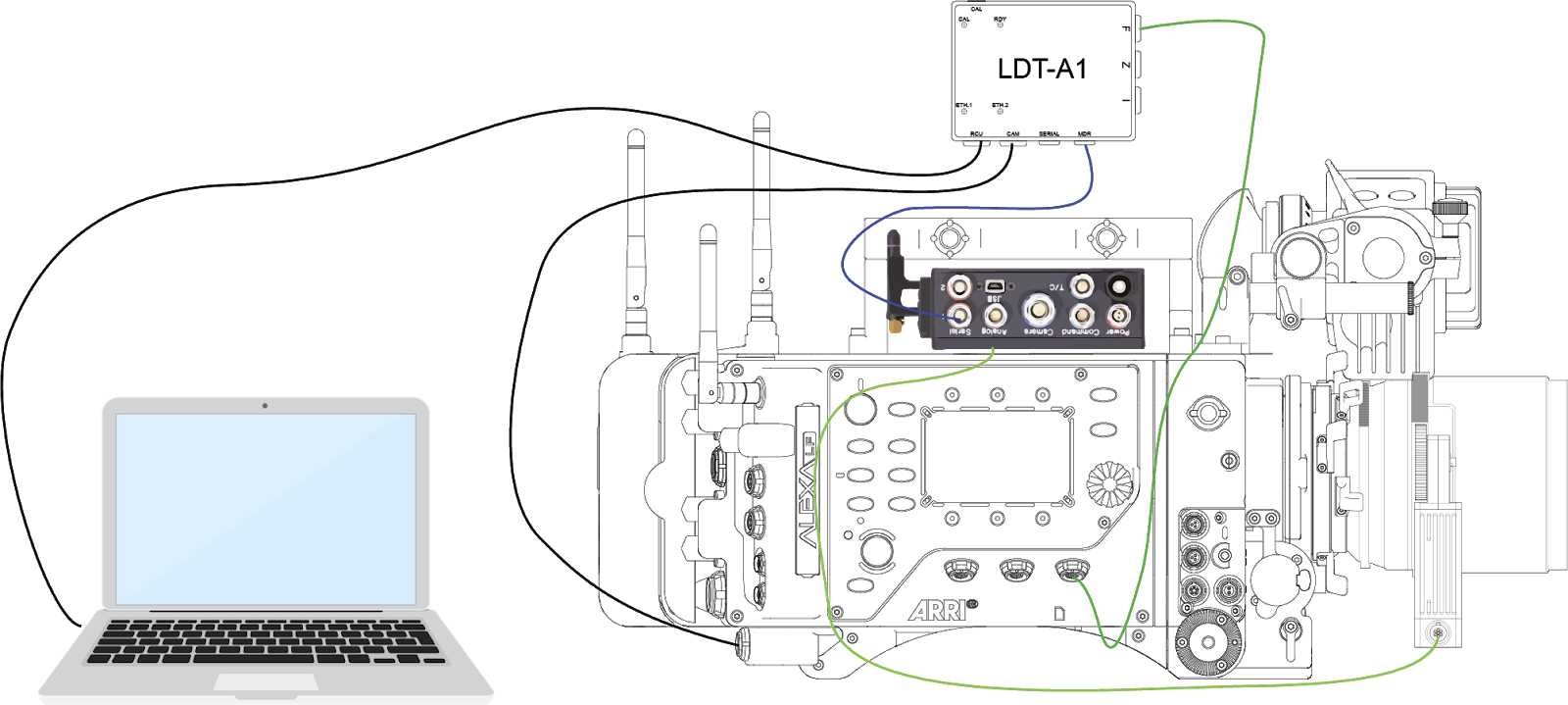
¶ Accessing the ALEXA WebRemote Interface
Each ALEXA camera contains a built-in remote control web interface (WebRemote) that can be accessed through an Ethernet connection. Part of the WebRemote is the LDA (Lens Data Archive) tab for the creation and storage of new lens tables with the ALEXA cameras.
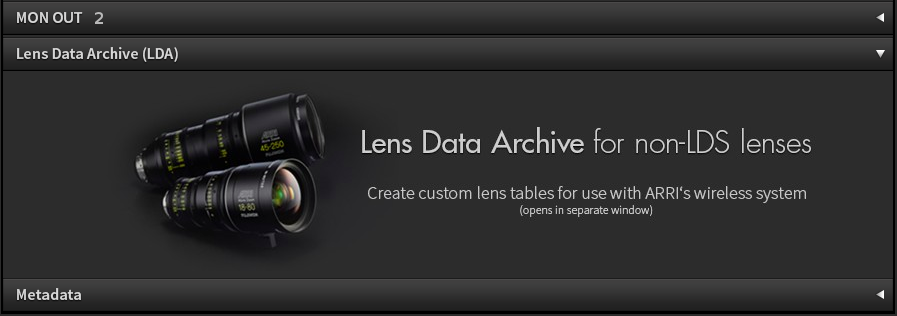
Once the ethernet cable is connected, on your laptop, leave the IP configuration on the Network Adapter of your laptop to DHCP. Open the web browser and enter address alexa####.local/, with #### being the camera serial number. In order to find the ALEXA serial number, on the camera press: INFO button > Version > Cam serial no.
Enter the 4-digit of the camera serial number, the web browser will now connect to the camera. At the end of the page click on Lens Data Archive (LDA).
¶ Adding a New Lens
Upon selecting the LDA tab, click on the Start New Session button. A browser screen with lens scales will appear.
Mount a new lens to the camera. On the LDT-A1 press the calibrate button.
The lens scales are displayed on the LDA browser screen once the respective motors have been calibrated.
The green ![]() symbol indicates the current position of the motor attached to the lens.
symbol indicates the current position of the motor attached to the lens.
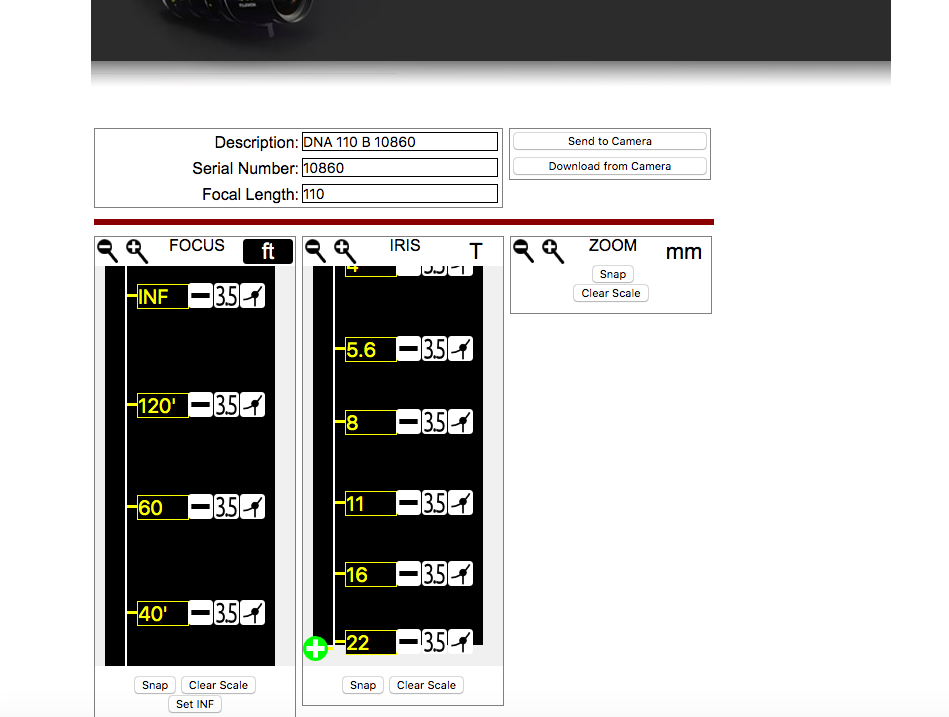
Fill in the lens description fields. Lens descriptions will be shown on the LDS screens and/or embedded as metadata.
- Description: Lens description that will be displayed on the camera and embedded as metadata. Should include lens type, focal length and serial number.
- Serial Number: Lens serial number will be embedded as metadata. Only use numbers, no letters.
- Focal Length: Focal length in mm. Will be shown on LDS screens and embedded as metadata. Enter 0 (zero) for zoom lenses.
For example:
Prime
- Description : G Series 45 5432
- Serial Number: 5432
- Focal Length: 45
Zoom
- Description : Angenieux 25-250mm 351
- Serial Number: 351
- Focal Length: 0
¶ Adjusting direction on WebRemote
In the WRS menu, change the direction of the motors from RIGHT to LEFT so that:
- On the Focus scale, infinity is on top of the scale and close focus is at the bottom of the scale (as previously noted ensure the preston motors are the correct direction before starting this),
- Iris wide open should be at the top of the scale and fully closed at the bottom,
- Zoom wide should be at the top of the scale and tight at the bottom (as per the picture above).
You should ignore “left” or “right” as a value, just change from left to right in order that the scale is correct.
Ensure that when moving the motor on each axis the icon goes to the very end of the scale. Check this on all axis’ before proceeding.
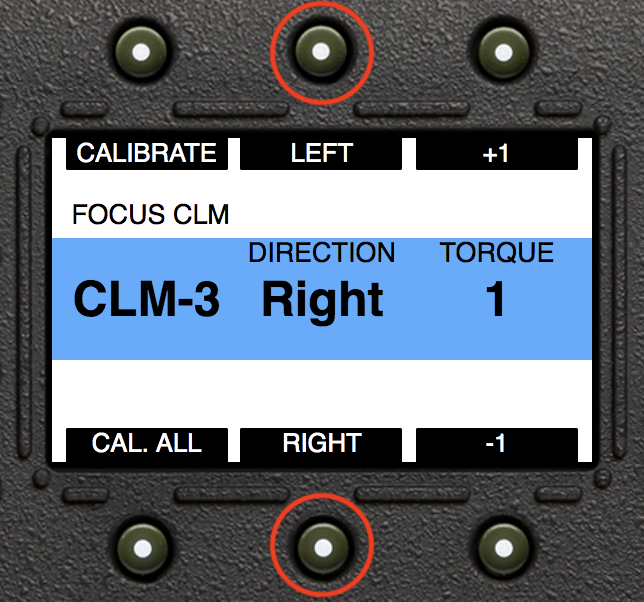
.png)
¶ Mapping a Lens Table
Once all the lens information is entered, start encoding the focus axis to start mapping the lens. F-Map should be turned off while mapping the lenses.
¶ Mapping the Focus Axis
Use the Preston focus knob to move through the span of the axis, ensuring that it reaches each end of the lens. If not, check if there were any slips during calibration.
Select the unit of measurement (metric or imperial) by clicking on the ft/m icon in the upper right corner of the focus scale. If you want to program the lens for both metric and imperial units, you need to program both scales seperately.
Check that the infinity mark is on top of the scale and close focus is at the bottom of the scale, if it is not then please reverse the direction of the motor in the WRS menu on the camera.
Click the plus icon to zoom in until there is roughly an inch on the screen between each data point on the lens. The more you are zoomed in the more accurate the map will be.
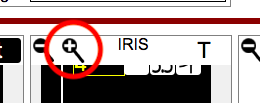
Start entering the infinity mark by clicking on the green + in the LDA browser scale or hit the ENTER button on your keyboard to enter the mark, type the value (type ‘i’ for entering the infinity mark)
Move the focus knob to the next lens engraved mark.
When you have inputted all the focus points and get to close focus, ensure a point is added at the very end of the scale even if it doesn't exist on the lens. So set the lens to it’s maximum close focus and measure or estimate the value.
For example: if the lens has a close focus marked as 1’9 but the close focus is past this then add a point at the very end of the scale and enter 1’6.
Depending on the unite measured used, the LDA requires the data to be type using a specific convention:
- Imperial scale: To enter feet values by using the prime symbol (’) and enter inch values by using the double prime symbol (”). The prime symbol for feet values can be used to separate feet and inch values.
For example:
21 inches: 1’9 or 21“
14.5 inches: 1’2.5 or 14.5“
20 feet: 20’
There is no need for values in both feet and inches to put the (“) symbol at the end. So 6”6 is acceptable.
- Metric Scales: Enter metric values as meters.
For example:
80 centimeters: 0.8
5.5 meters: 5.5
30 meters: 30
¶ Mapping the Iris Axis
Use the Preston HU3 slider or Preston SCH to move through the span of the iris axis, ensuring that it reaches each end of the lens. If not, check if there were any slips during calibration.
Check that the iris wide open mark is at the top of the scale and the closed down mark is at the bottom of the scale , if it is not then please reverse the direction of the motor in the WRS menu on the camera.
Click the plus icon to zoom in until there is roughly an inch on the screen between each data point on the lens. The more you are zoomed in the more accurate the map will be.
Start entering the wide open mark by clicking on the green + in the LDA browser or hit the ENTER button on your keyboard to open the edit field and enter the current lens value.
Move the iris slider to the next lens engraved mark.
When you have inputted all the iris points and get to the close down mark, ensure a point is added at the very end of the scale even if it doesn't exist on the lens. So set the lens to it’s maximum iris and measure or estimate the value.
For example: if the lens is marked until T22 but it goes further add a point at the very end of the scale and mark it as T32.
¶ Mapping the Zoom Axis
Use the Preston Microforce to move through the span of the axis, ensuring that it reaches each end of the lens. If not, check if there were any slips during calibration.
Check that the zoom wide should be at the top of the scale and tight at the bottom of the scale, if it is not then please reverse the direction of the motor in the WRS menu on the camera.
Click the plus icon to zoom in until there is roughly an inch on the screen between each data point on the lens. The more you are zoomed in the more accurate the map will be.
Start entering the wide zoom mark by clicking on the green + in the LDA browser or hit the ENTER button on your keyboard to open the edit field and enter the current lens value.
Check that the Zoom wide mark is at the top of the scale and tight at the bottom of the scale.
Move the zoom control to the next lens engraved mark.
When you have inputted all the zoom points and get to the tight mark, ensure a point is added at the very end of the scale even if it doesn't exist on the lens. So set the lens to it’s maximum iris and measure or estimate the value.
For example: if the lens is marked until 32mm but it goes further add a point at the very end of the scale and mark it as 28mm.
¶ Deleting Data Points
A data point can be deleted by moving the point to the screen scale index. Once there, the icon changes from the green + symbol to a red - symbol and can be deleted by clicking on the red - symbol or by pressing Enter on the keyboard. Click the Clear Scale button to delete all data points on the respective scale.
¶ Saving a Lens Table
Once the relative axis has been mapped, the lens table can be sent to the camera.

Reload the web page. Then clear LDA on the camera.
Save the newly created lens table into the camera’s internal Lens Data Archive (LDA) by hitting the Send to Camera button in the LDA browser. The lens file will then be processed and stored inside the ALEXA LDA User Archive section.
The WebRemote will prompt an error message in case of any logical data errors within the lens file. If this happens then check the data consistency of the lens values in the LDA browser and correct them.
Reload the browser, then click Download from Camera to download any existing lens table from the ALEXA LDA User Archive to the computer. Save the lens tables onto an SD card if you want to load them into another camera from the SD card. The SD card folder structure should be: ARRI/ALEXA/LDA.
¶ Transfer a Lens Table
Users can select a lens file stored on the SD card in their camera.
Insert the SD Card into a computer to transfer lens files to other cameras.
¶ Changing the Motors direction
If for rigging purpose a lens table needs to be reversed:
- Choose
WRS select the desired axis and change to Right or Left

¶ Selecting a Lens Table
The lens tables are recalled through the GUI of the camera:
- Choose
WRS > Lens data > LDA > Add> Add+Use
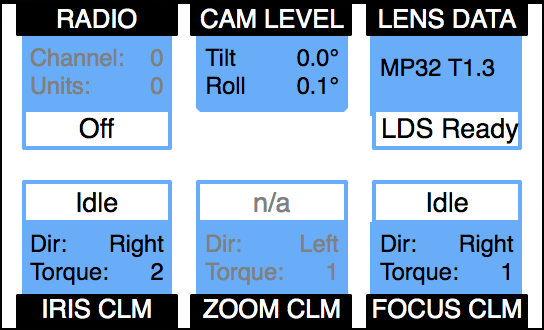
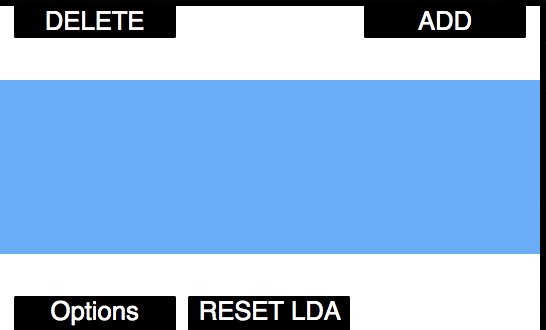
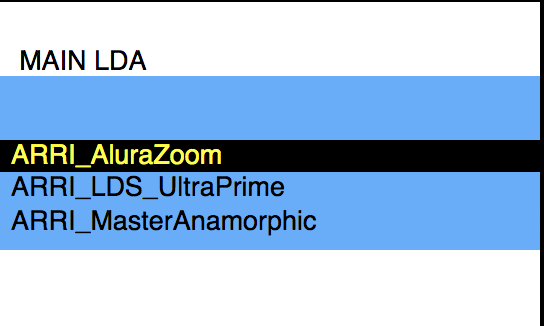
- Calibrate the lens using the calibration button on the LDT-A1.
¶ Testing the Lens Tables
Load the relative LDA Map from the WRS Menu
- Check lens lines up on the Lens Data page.
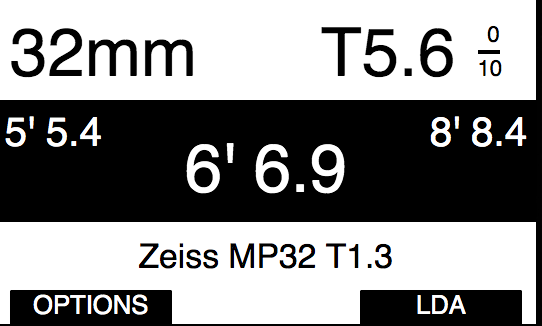
We suggest checking at least three random points to make sure it lines up.
¶ Shooting a Test
When shooting test footage, allow approximately one hour per camera type being used on the production. A test will involve recording the metadata (internally or injected) with a camera and recording a separate feed from the camera with an overlay to verify the data is correct at the final stage of the test. We recommend using a zoom lens (if any are being used during the shoot) in order to check all three axes.
To do a test:
- Encode a lens and test it (see Programming a New Lens Table),
- Shoot test footage in camera and record separate overlay feed at the same time,
- Extract the lens medatada from the ARRIRAW (see Extracting data from ARRIRAW footage),
- Merge the extracted CSV files to the EXR,
- Compare the metadata of the EXR file to the overlay footage.